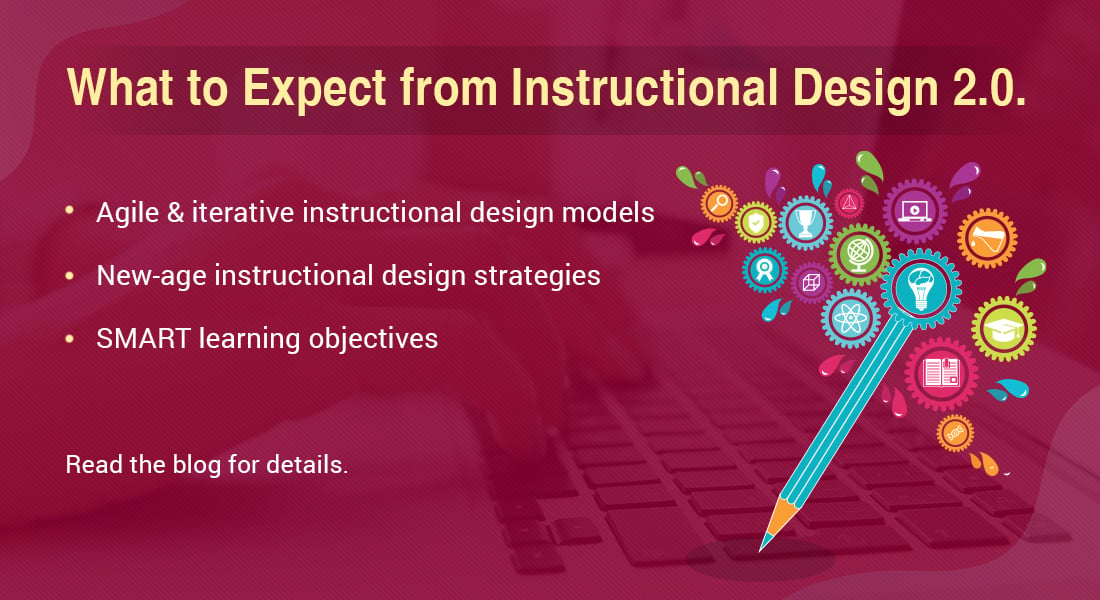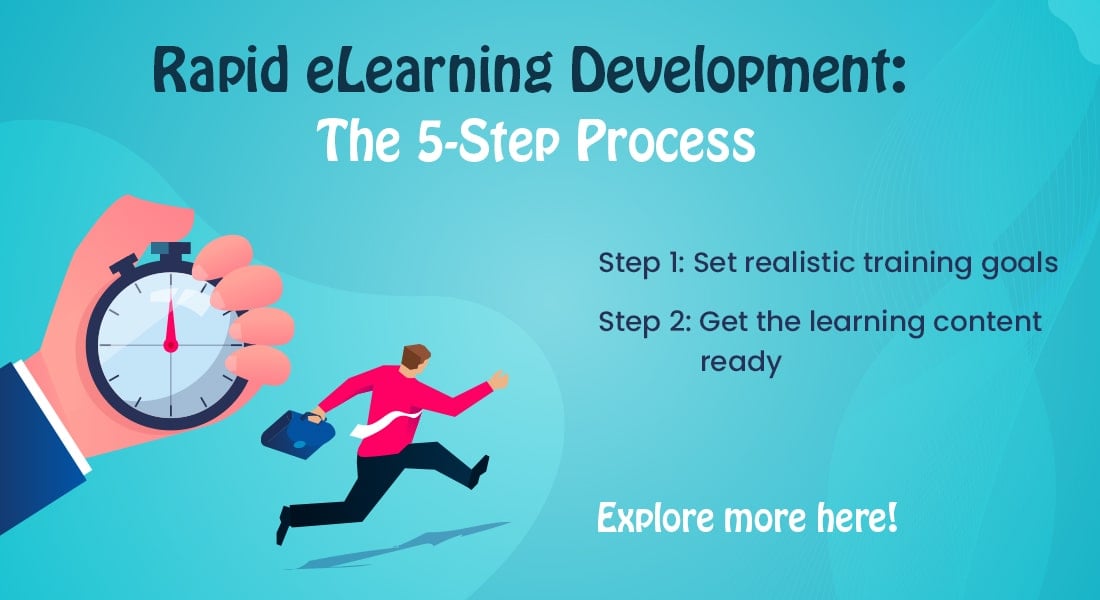What if there was a proven formula to consistently design successful training programs? Why do some eLearning courses drive real behavior change while others barely make an impact? How can you ensure your training content not only looks good but also delivers measurable results?
In the world of instructional design and corporate training, these aren’t just questions—they’re the daily challenges learning professionals face. The solution? A structured, time-tested framework known as the ADDIE model.
The ADDIE model—Analyze, Design, Develop, Implement, and Evaluate—is the foundation of effective learning design. It guides instructional designers, training managers, and L&D teams in creating purposeful, learner-focused training programs that align with business goals.
Download Now: Instructional Design 101
Whether you're designing a new onboarding course, developing compliance training, or revamping existing content, the ADDIE model offers a clear, repeatable process to get it right—every time. In this post, we’ll take a deep dive into what the ADDIE model is, how each phase works, its pros and cons, and how to apply it in modern eLearning environments.
Ready to build smarter, stronger learning experiences? Let’s get started.
Table Of Contents
- What is the ADDIE Model and Why is it Important in eLearning?
- What Are the 5 Phases of the ADDIE Model?
- What Are the Pros and Cons of the ADDIE Model?
- How is the ADDIE Model Used in Corporate Training?
- How Does ADDIE Compare with Other Training Models?
- How Can You Use the ADDIE Model Effectively?
- Are There Alternative Versions of the ADDIE Model?
- What Are Some Examples of the ADDIE Model in Action?
- What Are Some Common FAQs About the ADDIE Model?
- Conclusion
1. What is the ADDIE Model and Why is it Important in eLearning?
Instructional design is the art and science of creating effective, engaging, and relevant training programs. It's about more than just delivering information; it's about designing experiences that facilitate true knowledge acquisition and skill development. Without a structured approach, training initiatives can quickly become disjointed, inefficient, and fail to deliver measurable results.
Enter the ADDIE Model – a powerful, systematic framework that has become a cornerstone of instructional design, particularly in the realm of eLearning. ADDIE provides a clear roadmap, guiding designers and developers through a logical sequence of steps to create high-quality learning solutions.

The ADDIE Model is characterized by its five distinct, yet interconnected, phases: Analyze, Design, Develop, Implement, and Evaluate.
The ADDIE framework provides a systematic way to design, develop, and evaluate training programs. Whether you're creating onboarding modules, compliance training, or leadership development courses, ADDIE ensures your training meets the needs of both learners and organizations.
2. What Are the 5 Phases of the ADDIE Model?
Organizations embrace structured models like ADDIE for several compelling reasons: they ensure consistency in content and delivery, allow for scalability across various training needs, and most importantly, enable the tracking and measurement of learning outcomes. By following a defined process, organizations can confidently invest in training programs that deliver a clear return on investment.
Its origins trace back to the US Army in the 1970s, where it was developed as a systematic process for designing training materials. Over the decades, its efficacy led to its widespread adoption across various sectors, including corporate training, higher education, and government.
What Does ADDIE Stand For and Why Does It Matter in eLearning?
ADDIE is an acronym for the five stages of a development process including Analysis, Design, Development, Implementation, and Evaluation. Each phase of the ADDIE Model plays a critical role in the overall success of an eLearning project.
The primary purpose of ADDIE is to ensure that learning courses are not just created, but are specifically tailored to meet identified learner needs and align with broader organizational goals. Despite the rapid evolution of technology and learning methodologies, ADDIE remains incredibly relevant in modern eLearning and corporate training settings due to its robust and adaptable framework.
Let's dive deeper into each.
A. What Happens in the Analyze Phase?
This foundational phase is all about understanding the "what" and "why" of the training. It's about asking crucial questions to ensure the subsequent phases are built on a solid understanding of the context and needs.
- Identify training needs through needs assessment: What performance gaps exist? What new skills or knowledge are required?
- Define clear, measurable learning objectives: What should learners be able to do after completing the training? (e.g., "By the end of this module, employees will be able to accurately process customer refunds.")
Here’s a simple 3-step formula to make them clear, measurable, and learner-focused—every single time.
- Conduct audience analysis: Who are the learners? What are their demographics, prior knowledge, existing skill sets, and learning preferences?
- Perform gap analysis: What is the difference between the current state and the desired state of performance or knowledge?
- Gather data: Use various methods such as surveys, interviews, focus groups, observation, and performance metrics to collect comprehensive information.
B. What is Involved in the Design Phase?
The Design phase is where the blueprint for the course is meticulously crafted. It's about planning how the learning objectives will be met.
- Create a blueprint of the course: This includes defining the overall structure, content outline, and learning flow.
- Align learning objectives with content and assessments: Ensure every piece of content and every assessment directly contributes to achieving a specific learning objective.
- Choose instructional design strategies: Select appropriate methods to deliver the content, such as storytelling, case studies, simulations, gamification, or microlearning.
- Design storyboards, course maps, and assessment plans: Visualizing the course flow, detailing content for each screen, and outlining how learning will be measured.
- Plan for learner engagement and multimedia integration: How will learners interact with the content? What visuals, audio, or video will enhance the learning experience?
C. How is the Develop Phase Executed?
This is the creation phase, where the design plan is transformed into tangible learning materials.
- Convert the design plan into actual learning materials: This involves producing eLearning courses, video lectures, interactive quizzes, job aids, and other resources.
- Use authoring tools: Leverage industry-standard tools like Articulate 360 (Storyline, Rise), Adobe Captivate, Lectora, or iSpring Suite to build interactive and engaging content.
- Create prototypes and conduct alpha testing: Develop initial versions of modules or sections to test functionality, user experience, and content accuracy with a small group.
- Revise content based on feedback: Incorporate insights from alpha testing to refine and improve the learning materials before wider deployment.
- Ensure SCORM/xAPI compliance for LMS integration: Ensure the course can communicate effectively with Learning Management Systems (LMS) for tracking progress and completion.
D. What Happens in the Implement Phase?
The Implement phase is about rolling out the completed learning solution to the target audience.
- Deliver the course to the target audience: Make the learning content accessible to learners.
- Upload content to LMS or distribute through other delivery platforms: Utilize an LMS for tracking, reporting, and managing learners, or other platforms for direct access.
- Train instructors or facilitators if applicable: If the course involves guided instruction, ensure facilitators are prepared.
- Provide learners with guidance and technical support: Offer clear instructions on how to access and navigate the course, and provide channels for technical assistance.
- Monitor the rollout for any technical or engagement issues: Keep an eye on learner progress, technical glitches, or areas where engagement might be low.
E. Why is the Evaluate Phase Critical?
The Evaluate phase is crucial for determining the effectiveness of the training and ensuring continuous improvement. It’s not an afterthought but an integral part of the process.
- Conduct formative evaluation during development: This involves ongoing assessment and feedback collection throughout the Analyze, Design, and Develop phases to identify and fix issues early.
- Run summative evaluation after implementation: Measure the overall success of the training program after it has been delivered.
- Use learner feedback, assessment scores, and performance metrics: Collect data through surveys, quizzes, observation, and real-world performance indicators.
- Evaluate ROI and business impact of training: Determine if the training achieved its intended business objectives and delivered a return on investment.
- Feed insights back into future training initiatives (continuous improvement): Use the evaluation findings to refine existing courses and inform the design of new ones, creating a cycle of improvement.

Instructional Design 101
A Handy Reference Guide for eLearning Designers
- eLearning standards
- Streamlined instructional design process
- Effective assessments
- And More!
3. What Are the Pros and Cons of the ADDIE Model?
The ADDIE model provides a structured approach to course design, ensuring alignment with learner needs and goals. It supports multiple training formats and includes built-in evaluation. However, it can be time-consuming and less agile than iterative models. Extensive upfront planning may also make it feel rigid in fast-paced environments.
Pros of the ADDIE Model
- Provides a clear, structured process: Offers a systematic and logical flow for course creation, reducing ambiguity.
- Ensures alignment between training goals and learner needs: The Analyze phase ensures the training directly addresses identified gaps and objectives.
- Incorporates evaluation at multiple stages: Both formative and summative evaluations are built into the model, leading to higher quality.
- Flexible enough to adapt to different training contexts: While linear, its phases are broad enough to be applied to various types of learning projects.
- Works well for both classroom and eLearning environments: Applicable across different delivery modalities.
Cons of the ADDIE Model
- Can be time-consuming due to its sequential nature: Moving from one phase to the next can be slow, especially for large projects.
- Less agile compared to iterative models like SAM: Its linear structure can make it difficult to quickly adapt to changing requirements or integrate rapid feedback.
- Requires extensive upfront analysis and planning: A thorough Analyze phase is essential, which can be resource-intensive.
- May feel rigid if not adapted for modern, fast-paced training needs: Strict adherence can sometimes hinder quick iterations needed in today's dynamic environments.
4. How is the ADDIE Model Used in Corporate Training?
The ADDIE Model is a workhorse in corporate Learning & Development (L&D) teams. Its systematic approach makes it ideal for developing a wide range of training programs, from onboarding new hires to ensuring compliance and upskilling existing employees.
For instance, an L&D team might use ADDIE to build a comprehensive compliance eLearning module on data privacy. They would first Analyze the regulatory requirements and target audience, then Design the course structure and interactive scenarios, Develop the SCORM-compliant modules using authoring tools, Implement it on the company LMS, and finally Evaluate completion rates, quiz scores, and employee adherence to policies.
Similarly, for creating blended onboarding programs, ADDIE ensures that both online modules and in-person sessions are cohesively designed, address critical onboarding needs, and are systematically evaluated for effectiveness in integrating new employees. The benefits for large-scale training are immense: consistency across departments, scalability for growing workforces, and clear alignment with overarching business goals.
Mini Case Study: Global Sales Training
A multinational corporation needed to roll out a new product training program to its global sales force. Using ADDIE, the L&D team first Analyzed the sales team's existing product knowledge and identified performance gaps. They then Designed a blended learning approach, combining self-paced eLearning modules with virtual instructor-led sessions for Q&A and role-playing. During Development, they created interactive simulations and localized content for various regions. The Implementation phase involved launching the course on a global LMS and providing regional support. Finally, the Evaluation phase tracked sales performance metrics related to the new product, demonstrating a clear ROI and leading to further refinements in subsequent training cycles.
5. How Does ADDIE Compare with Other Training Models?
While ADDIE is a robust framework, other models such as SAM, Agile Learning Design, Rapid Instructional Design and more have emerged, often addressing some of ADDIE's perceived limitations, particularly concerning speed and agility.
ADDIE vs SAM (Successive Approximation Model)
SAM is an iterative and agile instructional design model that emphasizes rapid prototyping and continuous feedback loops. Unlike ADDIE's linear flow, SAM allows for quicker development cycles and immediate adjustments, making it suitable for projects with evolving requirements or tight deadlines.
ADDIE vs Agile Learning Design:
Agile methodologies, borrowed from software development, prioritize continuous iteration, collaboration, and responsiveness to change. While ADDIE can be adapted to be more agile, pure Agile Learning Design often involves shorter sprints and frequent releases, contrasting with ADDIE's more phased approach.
ADDIE vs Rapid Instructional Design (RID):
RID is not a distinct model but rather a philosophy that aims to compress or streamline the ADDIE phases to accelerate development. It often involves concurrent activities and a focus on essential elements to deliver training quickly.
So, when should you choose ADDIE? ADDIE remains an excellent choice for complex, large-scale projects where thorough upfront planning, detailed documentation, and a systematic approach are critical. However, it can also be combined with agile practices (e.g., iterative development within the Develop phase) to create a hybrid approach that leverages ADDIE's structure while incorporating flexibility.
6. How Can You Use the ADDIE Model Effectively? (Best Practices)
To maximize ADDIE's potential in today's fast-paced learning environment, consider these best practices:
- Adapt ADDIE to be more iterative: Instead of strictly linear, think of the phases as overlapping and allowing for feedback loops. For example, design elements can be refined based on prototype feedback during development.
- Involve stakeholders and SMEs early in the Analyze phase: Their insights are invaluable for accurately defining needs and objectives.
- Gather learner feedback at multiple stages, not just the end: Conduct usability testing during development, not just after full implementation.
- Use modern authoring tools to speed up the Develop phase: Tools with pre-built templates, themes, and interactive elements can significantly reduce development time.
- Combine with Agile principles for rapid updates and continuous improvement: Implement shorter cycles of development and evaluation, allowing for quicker adjustments and enhancements.

7. Are There Alternative Versions of the ADDIE Model?
Yes, while the core five phases remain, many organizations and practitioners have adapted ADDIE to better suit their specific needs and the demands of modern learning.
- Iterative ADDIE: This approach emphasizes that phases can overlap and loop back. For instance, initial development might trigger a need for further analysis or design refinement.
- Cyclical versions: Some adaptations portray ADDIE as a continuous cycle, highlighting that the Evaluation phase feeds directly back into a new Analysis phase for subsequent iterations or improvements.
- Modern adaptations: Many contemporary versions are tailored for microlearning, mobile learning, and digital learning ecosystems, often streamlining certain steps or integrating technology more deeply into each phase. Examples include "LLAMA" (Lay Out, Learn, Assets, Make, Announce) or "SAM" (Successive Approximation Model), which, while distinct, often incorporate elements of ADDIE's logic in an accelerated fashion. Many organizations customize ADDIE to allow for faster development cycles, particularly for rapid eLearning needs.

Instructional Design 101
A Handy Reference Guide for eLearning Designers
- eLearning standards
- Streamlined instructional design process
- Effective assessments
- And More!
8. What Are Some Examples of the ADDIE Model in Action?
Let's look at a few practical scenarios:
Developing a Leadership Training Program:
A practical example of the ADDIE model in action is developing a leadership training program. In the Analyze phase, gaps in leadership skills—such as poor delegation or ineffective communication—are identified using surveys and 360-degree feedback. The Design phase involves outlining modules on communication, delegation, and coaching, incorporating scenario-based learning and role-playing activities. During the Develop phase, online modules with interactive videos, exercises, and resources are created. The program is then Implemented via an LMS, with facilitator support for blended sessions. Finally, in the Evaluate phase, improvements in leadership behavior are measured through assessments and observed changes in team performance.
Creating a Compliance Course with eLearning Modules (e.g., Anti-Harassment Training):
At our organization, we followed the ADDIE model to develop an anti-harassment compliance eLearning course. In the Analyze phase, we identified legal requirements, company policies, and common non-compliance areas, targeting all employees. During Design, we structured the course with sections on definitions, examples, reporting procedures, and included interactive quizzes and scenarios. We Developed the content using an authoring tool, incorporating diverse, real-world situations and clear calls to action. The course was Implemented via our LMS with set deadlines and learner support. Finally, we Evaluated effectiveness by tracking completion rates, assessment scores, and conducting follow-up surveys.
Corporate Case Study: Onboarding Program for New Software Engineers:
A tech company used ADDIE to overhaul its onboarding for new software engineers. They Analyzed that new hires struggled with understanding the company's proprietary codebase. They Designed a phased onboarding program with self-paced coding challenges, mentorship pairings, and a capstone project. During Development, they created a series of interactive coding labs and a knowledge base. The program was Implemented over eight weeks. Evaluation showed a significant reduction in the time it took new engineers to contribute to projects, demonstrating a clear ROI for the structured onboarding.
9. What Are Some Common FAQs About the ADDIE Model?
Is ADDIE still relevant in 2025 with AI and rapid eLearning?
Absolutely. While tools and methodologies evolve, the core principles of understanding needs, designing solutions, building them, delivering them, and evaluating their impact remain timeless. AI can assist in various ADDIE phases (e.g., content generation in Develop, data analysis in Evaluate), and rapid eLearning often compresses ADDIE steps, but the underlying logic persists.
How long does it take to create a course using ADDIE?
There's no single answer. It depends heavily on the project's complexity, scope, available resources, and the number of subject matter experts involved. A simple microlearning module might take days or weeks, while a comprehensive leadership development program could take months.
Can ADDIE be used for microlearning or blended learning?
Yes, ADDIE is highly adaptable. For microlearning, you simply apply the ADDIE phases to smaller, focused learning chunks. For blended learning, ADDIE helps you strategically integrate online and offline components, ensuring a cohesive and effective learning journey.
How does ADDIE integrate with modern tools like AI and data analytics?
ADDIE integrates seamlessly with AI and data analytics to enhance each phase. AI helps identify skill gaps, personalize learning paths, generate content, tailor delivery, and analyze learner data. This makes the ADDIE model more adaptive, efficient, and impactful in modern training environments.
Final Thoughts on the ADDIE Model
The ADDIE model remains one of the most reliable frameworks in instructional design and eLearning development—and for good reason. Its structured, five-phase process gives learning professionals a clear path to follow while still allowing enough flexibility to adapt to changing needs, technologies, and learner expectations.
In a world where training must be agile, scalable, and results-driven, ADDIE serves as a powerful blueprint to create courses that actually work—not just in theory, but in practice. From onboarding and compliance to leadership development and performance improvement, the model ensures your training is purposeful, efficient, and measurable.
While newer models like SAM and Agile offer speed and iteration, ADDIE’s foundational value still shines—especially when blended with modern practices and tools. So, whether you’re building your first course or looking to streamline your design process, the ADDIE model is a great place to start (or return to).
Ready to create more effective and engaging training? Master the art and science of instructional design with our comprehensive eBook that covers everything from key eLearning standards to streamlined design processes. Learn how to craft effective performance-based learning objectives, present content for maximum impact, and apply proven ID strategies, methods, and tools to engage learners. Download your copy today and equip yourself with the skills to design learning experiences that truly deliver results.









